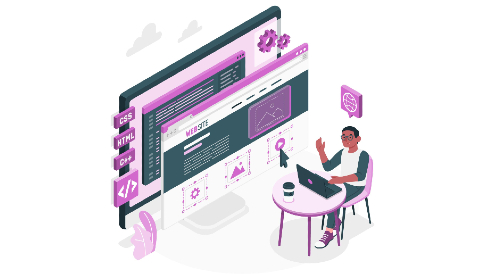6 Common UX Mistakes and How to Avoid Them
Did you know that for every $1 invested in UX, you can experience a $100 return on investment? That’s a 9,900 percent ROI! The potential is monumental but this is only going to be the case if you implement UX successfully. With that being said, in this blog post, we are going to delve deeper into User Experience (UX), revealing six of the most common UX mistakes you need to avoid to ensure UX success.
UX Mistakes – Failing to Research Effectively
There is only one place to begin, and this is with errors made with regard to user experience research. Maze’s guide on UX research is an excellent resource for more information about this. You will never be able to develop a successful and effective experience for your users if you do not research effectively.
Carrying out user research is systematic, and you can break this down into three pivotal areas: thinking of a question, getting all of the evidence, and evaluating this evidence to determine what it actually means. As a consequence, when researching, you must recognize that it is a continual process. It never ends. You always need to be finding out more about what your users want and need so that you can create human-centered and intuitive experiences.
As a consequence, skipping the research stage is one of the biggest design errors you can make. This is a vital component of the human-centered design process and a key part of generating solutions that meet your users’ expectations and deliver true value.
Forgetting about the Role Content Plays in UX
Content is still King – yes, we are using that phrase again! Content is only growing in importance, and we do not see any signs of this slowing down. For optimal UX, your website needs to feature premium quality, authoritative content from industry experts. Here are some of the tips that we have for you when it comes to using content effectively on your website:
- Create landing pages to boost conversions
- Guide users through the sales funnel by using content
- Revise old content to keep it relevant and fresh
- Post new blogs on a consistent basis
- Polish grammar and spelling
- Make sure quality is always one of your main priorities
- Use natural keywords across all of your content
While your aim is to climb up the search engine result pages, it is vital that you are developing content for the consumer rather than for the search engine. Use your brand’s tone and voice throughout. Provide value and interesting information to your customers – the sort of information they would want to share with others. Make sure you link to credible websites and cite your sources so that you can boost your site’s credibility as well.
Of course, from a UX standpoint, not only do you need to consider the sort of content you are offering your customers, but you also need to think about how you are presenting it. From infographics to videos, there are many different ways you can get your point across. Think about what sort of content medium is going to be most appropriate for your information. What would make the information easy and enjoyable to digest?
Creating Your Website for Google, Rather than Your Target Audience
An important part of UX design is creating consumer personas. A persona is a representation of your ideal customer. It helps you to understand your customers’ wants, needs, pain points, interests, hates, likes, and so on! This enables you to build something that is perfect for them. However, many website and product builders create something for the search engine rather than creating it for the user.
They become fixated on simply including keywords and links and stop thinking about what their website offers a real human user. It is important to remember that Google exists to satisfy user queries, so they want to present their users with the best websites. By developing a website for a human, you are, indirectly, designing a website for a search engine in any case. This is why you should always design with the user in mind.
It is important to remember why SEO came to be in the first place: to put together a set of website guidelines for optimizing the user experience. So while it may be important to design your site with SEO in mind, providing exceptional UX should be the ultimate goal. You can enjoy the best of both worlds. Create content for humans first, and then the search engine second.
Overlooking Responsive Design
There is no denying that this is one of the biggest UX mistakes we see a lot of businesses and individuals make today. Did you know that more than 90 percent of the worldwide population uses the mobile Internet? This is a staggering statistic. Smartphones overtook desktops as the most popular Internet device several years ago. Considering this fact, it is remarkable that many businesses out there have not created a responsive website. A responsive website is one that will adapt to the screen size it is being viewed on. We are sure you have all been there: you enter a website on your mobile phone, only to find that certain elements won’t load and that is difficult to click on buttons. This can be incredibly frustrating.
When this happens, it is because the desktop version of the website loads across all devices; it has not been optimized for use on a smaller device. When you consider that smartphones are most commonly used to access the Internet, there is simply no excuse for not having a website that is compatible with a smaller device. Responsive website design will ensure you deliver an optimal user experience across all devices.
Jumping on Every Trend Bandwagon
There are always new trends in the world of web design. They come and go all of the time. Just when you think you have mastered UX, a new trend pops up. While it can be tempting to try and implement every single trend that pops onto the scene, it is not only impossible but also incredibly exhausting, and quite frankly, it’s not usually worth it. Blindly adopting a new UX trend because everyone else seems to be doing so is never a great approach. Instead, take the time to evaluate your KPIs and determine whether or not making the change makes sense for your brand. It is all about looking at the risk versus the reward.
Some UX trends are going to have roots in consumer metrics and real data, so they may be able to elevate your user experience to new heights. However, there are other trends that have occurred because of bloggers looking to create a buzz, i.e., they do not have much substance. Therefore, your job is to figure out which trends are worth implementing and which are simply going to waste your time. But you can always hire a UI UX design agency or a UX studio that can help you deliver a timeless design. But if it’s not a good place, I can come up with another one.
Getting the Balance Between Functionality and Aesthetics Wrong
It should not be a case of prioritizing aesthetics over functionality or functionality over aesthetics – you need to have a balance of both. While it is critical to have aesthetic elements for UX, you need to ensure that these elements do not override your website’s functionality. Users want creativity, yet they also need to be able to navigate your website in a simple and easy manner.
At the same time, your site should not prioritize functionality to the point whereby creativity is completely dulled. If your website is purely function, and nothing more, it may end up boring your users, which will compel them to go to a different website. Complete functionality with no spark or excitement will make your brand easy to forget. This is the opposite of what any business is trying to achieve.
Instead, your website needs to be unique, creative, aesthetically pleasing, and visually captivating. This is the only way you are going to stand out and achieve brand loyalty. So, when it comes to designing a website with UX at the forefront, you should be looking to achieve a balance between functionality and aesthetics.
Final Words on UX Mistakes
So there you have it: some of the most common UX mistakes people have a tendency to make. We hope this has helped you better understand common user experience errors so that you can avoid making the same UX mistakes. From designing for the search engine instead of the user to forget about the importance of content, if you can avoid the errors mentioned above, you can go a long way to ensuring your site is perfectly optimized for user experience.




Leave a Reply